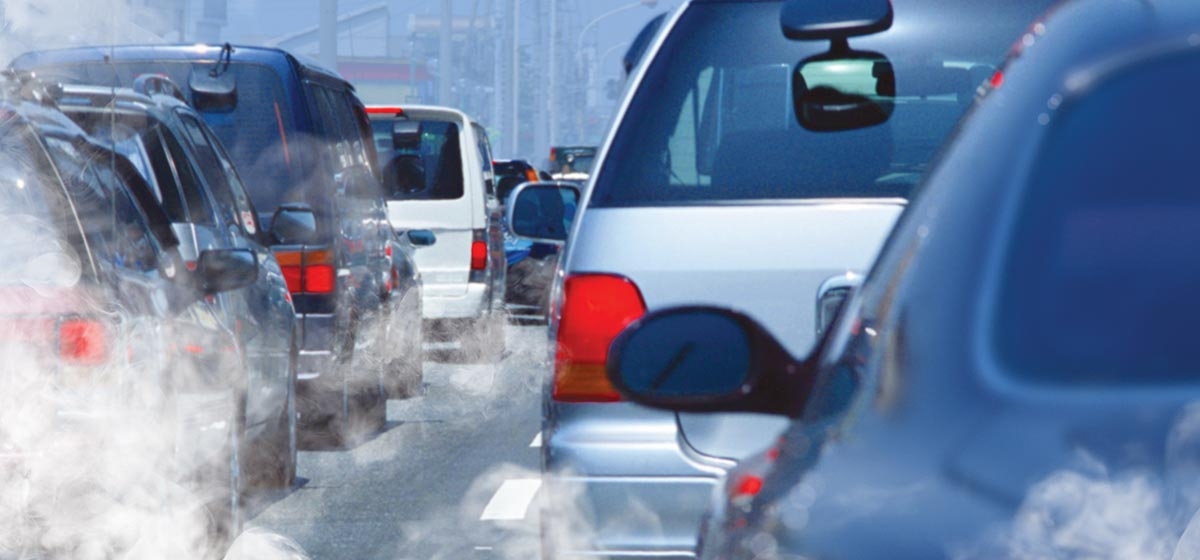
Creeping into the Fort Pitt Tunnel, angling for space at the Parkway East’s Grant Street exit, or elbowing into a gap in traffic on the Veterans Bridge, tens of thousands of people drive or ride into and out of Downtown nearly every day.
Trailing behind them are the often-invisible exhausts of internal combustion engines. At once more plentiful and less obvious a problem than sprawling facilities like U.S. Steel’s Clairton Works, these mobile sources of emissions make Downtown a hot spot for air pollution, according to measurements by Carnegie Mellon University scientists.
“It’s sort of a matter of scale,” said Albert Presto, a professor in CMU’s department of mechanical engineering and leader of a research team that takes air samples around the region in mobile labs. “Mobile sources are important in large part because there are so many of them.”
The transportation sector accounts for more than half the nitrogen oxide emissions, 30 percent of volatile organic compound emissions and more than one-fifth of particulate matter emissions in the country, according to the Environmental Protection Agency (EPA).
Nitrogen oxides and volatile organic compounds react to sunlight and form ground-level ozone, which studies have shown can damage lungs, aggravate diseases such as asthma, and generally make breathing more difficult. Particulate matter is associated with heart attacks and respiratory problems, along with environmental damage such as acidifying water and creating haze.
But it’s difficult to pin down exactly how much of the region’s air quality problems can be blamed on vehicles vs. heavy industry and coal-fired electricity generation, Presto said.
What is known is that all seven southwestern Pennsylvania counties in the EPA-designated Pittsburgh-Beaver Valley region are in nonattainment of the current 8-hour ozone standard, a status that requires special plans to remedy the violations.
More than 12 million vehicles were registered in Pennsylvania last year, including about 940,000 in Allegheny County.. That’s not quite one vehicle for each of the 12.8 million Pennsylvanians and 1.2 million county dwellers, but it’s close.
“Even if individual cars are pretty clean, when you have a million of them or half a million, that’s a lot of emissions,” Presto said.
Plus, we’re driving more.
Americans drove 3.2 trillion miles last year, according to the Federal Highway Administration, up from 2.7 trillion in 2000 and about 2.2 trillion in 1991.
Presto’s research team uses mobile measuring devices to analyze particulate matter and nitrogen oxides at points throughout Allegheny County. “We’ve built these maps that, instead of showing topography, show particulate matter concentrations,” he said.
The result looks like a road map. Red lines signifying the highest concentrations of pollutants follow the county’s most heavily traveled roads.
And the data identify places where concentrations are highest. “Downtown is one,” Presto said. “You have this huge influx of cars and people. Two times a day, there’s all of this activity. Oakland is another one because of the buses on Fifth and Forbes (avenues).”
As with stationary sources of air pollution, geography plays a role in what happens to pollutants expelled from tailpipes. Many larger roads run along rivers and through deep valleys. Such topography, combined with changes in temperature above and below ridgelines, can trap pollutants in valleys.
Presto said the “near-field impact” of vehicle exhaust spreads about 100 meters on either side of roadways. When there isn’t that much space on either side of the road— Downtown, for example—the pollutants “pile up.”
Still, conditions are much better than they used to be.
“The fact that cars and trucks have been getting cleaner in the past decades have helped drive down pollution. In general, air pollution is going down in Pittsburgh and nationwide,” Presto said.
The average carbon dioxide emissions for new vehicles in 2015 was 358 grams per mile, a record low, according to the Environmental Protection Agency. That’s a 22-percent drop since 2004, the agency reported. During the same period, average fuel economy increased about 28 percent, or 5.5 miles per gallon. In 1975, the average vehicle’s emissions were about 680 grams per mile and the average fuel economy was just over 13 miles per gallon, compared with nearly 25 miles per gallon in 2015.
“Carbon monoxide emissions have gone down by more than a factor of 10 if you go back … 40 years,” Presto said.
Ground-level ozone levels also have fallen significantly in the Pittsburgh-Beaver Valley region, which includes Allegheny, Armstrong, Beaver, Butler, Fayette, Washington and Westmoreland counties. However, counties generally have been unable to keep up with the tightening of National Ambient Air Quality standards for ozone over the years.
The EPA estimates its motor vehicle and fuel regulations—which it says led to automakers producing vehicles that are 99 percent cleaner today than in 1970—will, by 2030, prevent 40,000 premature deaths, 34,000 hospitalizations and 4.8 million lost work days every year.
The Clean Air Act led the EPA to phase out the use of lead in gasoline beginning in the 1970s. According to the agency, “Levels of lead in the air decreased 94 percent between 1980 and 1999.”
The most recent set of EPA motor vehicle and fuel regulations, known as Tier 3, began to take effect this year and will be fully phased in by 2025. They require gasoline refiners to cut the amount of sulfur from 30 parts-per-million to 10.
The change has been dramatic for diesel fuel as well. Before the EPA began regulating sulfur in diesel in 1993, the fuel contained as much as 5,000 parts-per-million, according to the agency. The latest regulations, phased in from 2006 to 2010, set a limit of 15 parts-per-million.
Fuel pouring into gas tanks doesn’t just change over the span of years; it shifts with the seasons.
“We have different fuel formulations in summer and winter,” Presto said. The mixture of gasoline sold in the summer evaporates slower than the winter mix. “How fast the fuel evaporates is important because of things like ozone,” which forms when nitrogen oxide and volatile organic compounds react with sunlight.
Even in a perfectly sealed fuel system, those pollutants would find their way into the air through a vehicle’s combustion process, which is why the Tier 3 regulations require automakers to clean up their exhaust. The new standards for passenger, light-duty and medium-duty vehicles require 80 percent reductions in automakers’ fleet-average emissions of ozone precursers, as well as a 70 percent reduction in particulate matter. For heavy-duty vehicles, such as large trucks, the standards for those pollutants are 60 percent lower.
For smaller operations and individual car owners, state and federal authorities have set up incentive programs to help bring newer, cleaner vehicles into use more quickly.
The EPA is not the only government agency requiring higher standards. Pittsburgh in 2016 passed a “Clean Construction” ordinance requiring city contractors on major projects to use ultralow sulfur fuel and equipment with the best-available pollution control technology. And the Pennsylvania State Clean Diesel Grant Program has, since 2008, helped replace 120 vehicles and retrofit 165 more with emission and idling-reduction equipment, according to state Department of Environmental Protection (DEP) data.
Most of the $3.4 million spent during that time came from the EPA, though the DEP has kicked in matching funds during some years. In the current fiscal year, the state plans to add more than $275,000 to the $413,000 it expects to receive from the EPA, said DEP spokesman Neil Shader.
The DEP also offers rebates as high as $1,750 to people who buy plug-in hybrid electric vehicles and battery-only electric vehicles through the state’s Alternative Fuels Incentive Grant Program. That’s in addition to federal tax credits and incentives from insurance and power companies.
The environmental benefit of increased use of plug-in vehicles is tempered by the environmental cost of producing electricity. Southwestern Pennsylvania consumes a significant amount of electricity generated by coal-fired power plants, which are among the most prolific sources of major air pollutants, such as fine particulates. But the use of coal in power generation is in decline across the nation.
“As long as the grid continues to get cleaner, electric vehicles can be a big win,” said Jeremy Michalek, a professor in Carnegie Mellon University’s department of engineering and public policy and director of CMU’s Vehicle Electrification Group and Design Decisions Laboratory. “If we want to meet targets like Paris (international climate accord) we’re going to need to overhaul our transportation. There are only a few options available to provide near-zero emissions, and electric vehicles are one.”
But it’s not just what people drive; it’s also how they drive.
A car will burn more fuel if its driver constantly stops at intersections and then accelerates away.
A multi-year partnership between Pittsburgh and Carnegie Mellon University has focused on making smoother travel more common through the use of “smart” traffic lights. Rather than working on a timer or an in-ground sensor like traditional traffic signals, the system that’s being tested uses an array of sensors to monitor traffic patterns and adjust immediately. When the sensors at one light see traffic coming, they change the light’s timing and pass along the information to other lights.
The late industrialist Henry Hillman sponsored early research into smart traffic signals. “He felt there was gridlock, and that the city struggled to maintain and preserve its infrastructure. At the same time, you have some of the brightest minds in the world at Carnegie Mellon, so how could they leverage all those resources?” said Alex Pazuchanics, assistant director for policy and planning in Pittsburgh’s department of mobility and infrastructure.
Research at the Intelligent Coordination and Logistics Laboratory in CMU’s Robotics Institute led to Surtrac, a network of smart traffic signals being used in East Liberty. The advanced signals were first installed five years ago at nine intersections along Penn Avenue in East Liberty. Early data suggested they reduced vehicle-wait-time by 40 percent, travel time by about 26 percent and estimated vehicle emissions by 21 percent.
The project has since grown to 50 intersections in the area. And the initiative has attracted some $30 million in federal, state and local grants.
Directly linking this new network to improvements in air quality poses its own challenges. Air is chaotic. Ozone, for example, forms through an ever-shifting mixture of wind-dispersed pollution, sunlight and temperature. And unlike stationary power plants, the cars are moving as well. “It can be hard to build that direct causation,” Pazuchanics said. “We feel pretty confident that a more optimized network is one that improves air quality.”





